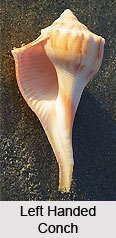 1. Left handed conch - It is also called the conch of the opposite hand. Keeping its top portion towards oneself, its open portion stays towards the left hand of the bearer of the conch.
1. Left handed conch - It is also called the conch of the opposite hand. Keeping its top portion towards oneself, its open portion stays towards the left hand of the bearer of the conch.
The left hand conch is used to make sounds. It is considered the brother of goddess Lakshmi and much loved by Lord Vishnu. During the period of the prehistoric Aryan Culture, it was looked upon as the symbol of shine, splendour and auspicious establishment. A conch shell is blown in every festival and every auspicious ceremony. Its sound reverberates in the atmosphere, filling one with fresh vigour. No worship is viewed concluded if a conch is not blown. There is no panic of paranormal activities and fright of ill spirits, as long as the sound of conch reaches far and wide. If it is blown while doing yoga activities, it exercises the lungs and respiratory tract, through which the body becomes free from diseases, especially cardiac disorders.

2. Right handed Conch - The conch bent on the right hand is also called right handed conch and when its top faces the worshipper, its open portion faces the right hand of the worshipper.
According to Hindu mythology, when the conch came up during the time of ocean-churning, Lord Vishnu had borne it in His right hand. Then Goddess Lakshmi took birth from the ocean and Lord Vishnu married her. Therefore, it bears intimate relationship with Goddess Lakshmi.
Authority of the conch shell remains the same regardless of it being big or small. It is a well-proven fact that the right handed conch gives wealth and prosperity.
More on Conch Shell
Conch Shell Sthaapana




















